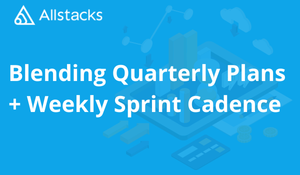To support that, like most software organizations, we have adopted Scrum as the lifecycle management approach we use in our day to day delivery. In fact, as we noted in a previous post: How One-Week Sprints Transformed Our Engineering Workflow at Allstacks - we have actually moved to 1 week sprints to enable rapid deployment of key customer capabilities. Additionally, we have implemented quarterly planning for our software development goals.
In this planning exercise we collect information throughout the organization regarding what is needed to:
- Support customers more thoroughly
- Improve the user experience
- Scale our product continuously
- Generally stay ahead of the growth curve we are on as a start-up software company
After that collection of data and initial sizing, we vote as a team on both what we will target for completion and very specifically, what we will hold aside for the time being. This gives us two obvious lists we can focus our efforts on - both the “to do now” and the “to do later”. This enables significant discipline in the execution of our plan - meaning we focus our energy to execute the stated plan without deviation - unless absolutely necessary due to an unforeseen circumstance.
This exercise “fills the gap” that can occur within Scrum if not careful. For perspective - Scrum and other Agile practices are focused on near term sprint execution and delivery. Without tie-in to the greater organizational goals, they can cause short term optimization of planning and in fact can at times undermine the companies stated macro initiatives.
Chart 1 below describes the initiatives selected for the quarter
Key Considerations:
- Businesses operate through quarterly patterns
- Objectives, earnings, budgets, and supporting communications follow quarterly cycles
- Software development benefits from following the same patterns
- Successful software organizations have processes which compliment those quarterly planning approaches
- Lead with quarterly plans (planning increments)
- Structure Initiatives and Epics to last no longer than a quarter
- Total alignment of software efforts with broader business objectives
- Day to day execution through sprints
- Execute sprints in 1-2 week increments
- Break down tasks into manageable chunks
- Maintain steady progress and agility
- Continually connect, align and monitor story and sprint attainment along with Epic completion.
Benefits of aligning business goals with software execution
When we successfully bridge the quarterly plan to the week to week sprints, several benefits occur. The first and perhaps most important of those is thorough organizational connectivity. Meaning that each individual contributor and team can see their contribution to organizational initiatives in every story and sprint they participate in and complete. This alignment can contribute to increasing the developer experience and overall team satisfaction with their production.
Other benefits we see:
- Predictability of completion
- Consistency of delivery and achievement
- Effective communication and collaboration throughout the organization
- Complete alignment of software projects and business goals
In chart 2 below - Initial status of initiatives at beginning of quarter
In chart 3 below - Final status of initiatives at end of quarter
Using Allstacks to know you are progressing successfully:
- Continually Measure progress with Allstacks
- Vital to visualize metrics data throughout the quarter
- Track quarterly Epics and achievement sprint-by-sprint
- Monitor estimates, actuals, and adjust as necessary
- Continuous measurement enables total visibility/achievement of business goals
Chart 4 below shows all of the detailed work completed in the quarter
Chart 5 below - Another view of the quarter - displaying the investment time we spent on each major initiative/epic
Allstacks enables the continual alignment of software development processes with predictable business patterns. Consistently measuring progress, organizations can unlock achievement visibility, effective communication, and collaboration. This harmonious approach fosters focus, keeps work relevant, mitigates risks associated with misaligned goals, and ensures data-driven success through continuous measurement.
If you would like to engage in further discussion about aligning your business goals with your software development and successful measurement of that alignment please reach out to us at Let's Talk Alignment!

Written By:





